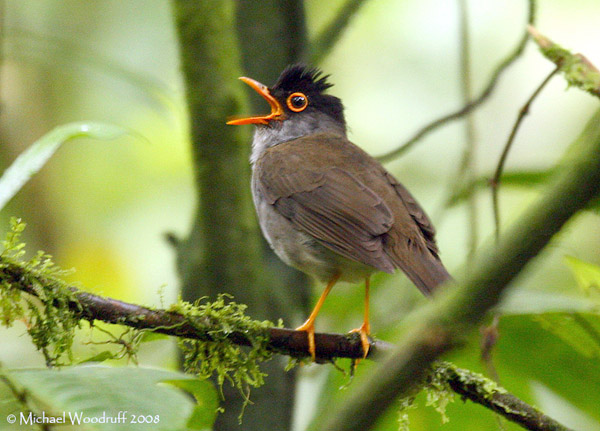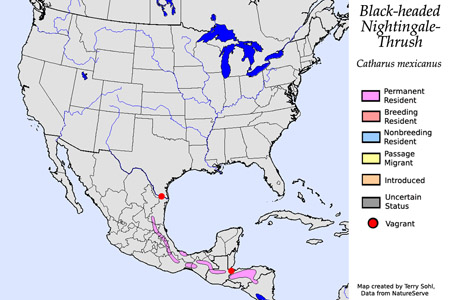| Length: 6.5 inches | Wingspan: 11 inches | Seasonality: Non-resident in South Dakota |
| ID Keys: Gray underparts, olive-brown upperparts, gray head with dark upper half, orange eyering, bill, and legs. | ||
 The
Black-headed Nightingale-Thrush is a songbird of Central America and parts
of eastern Mexico. Despite breeding 200 km away in northern Mexico,
the species was unknown in the United States until 2004, when a lone bird
was identified in Hidalgo County, Texas. They are primarily found in
mountainous forest areas, although they will move to lowlands outside of the
breeding season.
The
Black-headed Nightingale-Thrush is a songbird of Central America and parts
of eastern Mexico. Despite breeding 200 km away in northern Mexico,
the species was unknown in the United States until 2004, when a lone bird
was identified in Hidalgo County, Texas. They are primarily found in
mountainous forest areas, although they will move to lowlands outside of the
breeding season.
Habitat: Found in tropical or sub-tropical forests.
Diet: Feeds on insects and other small invertebrates, as well as fruits and berries.
Behavior: Black-headed Nightingale-Thrush are rather shy, preferring to stay in thick undergrowth and bushes while they forage. The best looks at the species typically occur when the male is singing on a higher, more visible perch. They can also sometimes be seen foraging along roadsides during the early morning hours.
Nesting: The nest is a cup of grasses, mosses, leaves, and other material, placed in a low shrub or occasionally on the ground. The female lays between 2 and 4 eggs.
Song: The song is a weak flute-like warbling
Migration: Considered a permanent resident throughout its normal range. However, some may move to lower elevations for the winter in parts of their range.
Interactive eBird map: Click here to access an interactive eBird map of Black-headed Nightingale-Thrush sightings
Similar Species: Obvious identification marks if seen well, not likely to be confused with another species.
Conservation Status: Populations appear to be in decline. However, they still are found in a number of locations and are common enough in parts of their range that overall populations are not considered threatened. The IUCN lists the Black-headed Nightingale-Thrush as a species of "Least Concern".
Further Information: 1) Cornell's NeoTropical Birds - Black-headed Nightingale-Thrush
2) BirdLife International - Black-headed Nightingale Thrush
3) Sora - First Record of a Black-headed Nightingale Thrush in the United States
Photo Information: Photo taken by Michael Woodruff - July 9th, 2008 - Costa Rica - Photo licensed under Creative Commons Attribution ShareAlike 2.0 Generic License
| Click below for a higher-resolution map |
 |
| South Dakota Status: Non-resident in South Dakota |
Additional Black-headed Nightingale Thrush Photos (coming soon!!)
